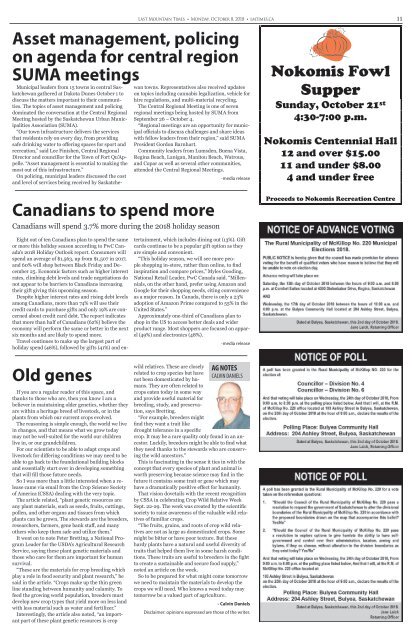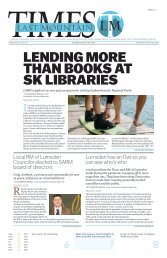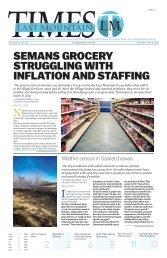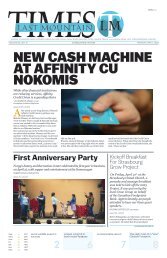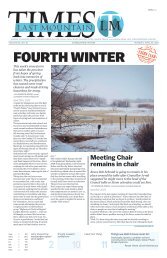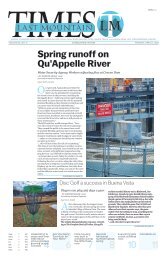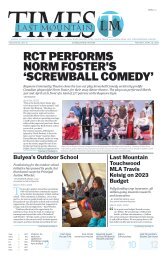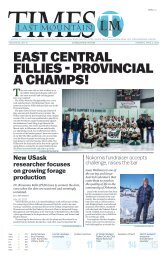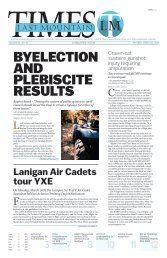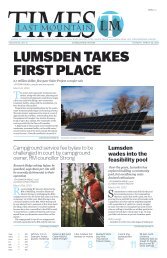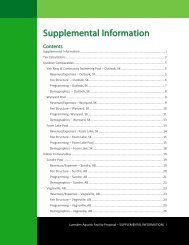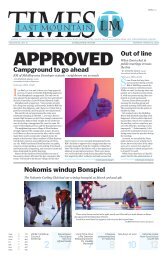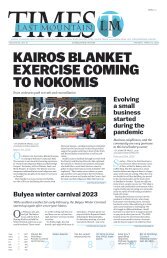LMT October 8th 2018
Create successful ePaper yourself
Turn your PDF publications into a flip-book with our unique Google optimized e-Paper software.
Last Mountain Times • Monday, <strong>October</strong> 8, <strong>2018</strong> • lmtimes.ca<br />
Asset management, policing<br />
on agenda for central region<br />
SUMA meetings<br />
Municipal leaders from 15 towns in central Saskatchewan<br />
gathered at Dakota Dunes <strong>October</strong> 1 to<br />
discuss the matters important to their communities.<br />
The topics of asset management and policing<br />
dominated the conversation at the Central Regional<br />
Meeting hosted by the Saskatchewan Urban Municipalities<br />
Association (SUMA).<br />
“Our town infrastructure delivers the services<br />
that residents rely on every day, from providing<br />
safe drinking water to offering spaces for sport and<br />
recreation,” said Lee Finishen, Central Regional<br />
Director and councillor for the Town of Fort Qu’Appelle.<br />
“Asset management is essential to making the<br />
most out of this infrastructure.”<br />
On policing, municipal leaders discussed the cost<br />
and level of services being received by Saskatchewan<br />
towns. Representatives also received updates<br />
on topics including cannabis legalization, vehicle for<br />
hire regulations, and multi-material recycling.<br />
The Central Regional Meeting is one of seven<br />
regional meetings being hosted by SUMA from<br />
September 26 – <strong>October</strong> 4.<br />
“Regional meetings are an opportunity for municipal<br />
officials to discuss challenges and share ideas<br />
with fellow leaders from their region,” said SUMA<br />
President Gordon Barnhart.<br />
Community leaders from Lumsden, Buena Vista,<br />
Regina Beach, Lanigan, Manitou Beach, Watrous,<br />
and Cupar as well as several other communities,<br />
attended the Central Regional Meetings.<br />
-media release<br />
Nokomis Fowl<br />
Supper<br />
Sunday, <strong>October</strong> 21 st<br />
4:30-7:00 p.m.<br />
Nokomis Centennial Hall<br />
12 and over $15.00<br />
11 and under $8.00<br />
4 and under free<br />
11<br />
Canadians to spend more<br />
Canadians will spend 3.7% more during the <strong>2018</strong> holiday season<br />
Proceeds to Nokomis Recreation Centre<br />
Eight out of ten Canadians plan to spend the same<br />
or more this holiday season according to PwC Canada’s<br />
<strong>2018</strong> Holiday Outlook report. Consumers will<br />
spend an average of $1,563, up from $1,507 in 2017,<br />
and 60% will shop between Black Friday and December<br />
25. Economic factors such as higher interest<br />
rates, climbing debt levels and trade negotiations do<br />
not appear to be barriers to Canadians increasing<br />
their gift giving this upcoming season.<br />
Despite higher interest rates and rising debt levels<br />
among Canadians, more than 74% will use their<br />
credit cards to purchase gifts and only 19% are concerned<br />
about credit card debt. The report indicates<br />
that more than half of Canadians (62%) believe the<br />
economy will perform the same or better in the next<br />
six months and are likely to spend more.<br />
Travel continues to make up the largest part of<br />
holiday spend (46%), followed by gifts (41%) and entertainment,<br />
which includes dining out (13%). Gift<br />
cards continue to be a popular gift option as they<br />
are simple and convenient.<br />
“This holiday season, we will see more people<br />
shopping in-store, rather than online, to find<br />
inspiration and compare prices,” Myles Gooding,<br />
National Retail Leader, PwC Canada said. “Millennials,<br />
on the other hand, prefer using Amazon and<br />
Google for their shopping needs, citing convenience<br />
as a major reason. In Canada, there is only a 23%<br />
adoption of Amazon Prime compared to 55% in the<br />
United States.”<br />
Approximately one-third of Canadians plan to<br />
shop in the US to access better deals and wider<br />
product range. Most shoppers are focused on apparel<br />
(49%) and electronics (48%).<br />
-media release<br />
Old genes<br />
If you are a regular reader of this space, and<br />
thanks to those who are, then you know I am a<br />
believer in maintaining older genetics, whether they<br />
are within a heritage breed of livestock, or in the<br />
plants from which our current crops evolved.<br />
The reasoning is simple enough, the world we live<br />
in changes, and that means what we grow today<br />
may not be well-suited for the world our children<br />
live in, or our grandchildren.<br />
For our scientists to be able to adapt crops and<br />
livestock for differing conditions we may need to be<br />
able to go back to the foundational building blocks<br />
and essentially start over in developing something<br />
that will fill those future needs.<br />
So I was more than a little interested when a release<br />
came via email from the Crop Science Society<br />
of America (CSSA) dealing with the very topic.<br />
The article related, “plant genetic resources are<br />
any plant materials, such as seeds, fruits, cuttings,<br />
pollen, and other organs and tissues from which<br />
plants can be grown. The stewards are the breeders,<br />
researchers, farmers, gene bank staff, and many<br />
others who keep them safe and utilize them.”<br />
It went on to note Peter Bretting, a National Program<br />
Leader for the USDA’s Agricultural Research<br />
Service, saying these plant genetic materials and<br />
those who care for them are important for human<br />
survival.<br />
“These are the materials for crop breeding which<br />
play a role in food security and plant research,” he<br />
said in the article. “Crops make up the thin green<br />
line standing between humanity and calamity. To<br />
feed the growing world population, breeders must<br />
develop new crop types that yield more on less land<br />
with less material such as water and fertilizer.”<br />
Interestingly, the article also noted, “an important<br />
part of these plant genetic resources is crop<br />
wild relatives. These are closely<br />
related to crop species but have<br />
not been domesticated by humans.<br />
They are often related to<br />
crops eaten today in some way<br />
and provide useful material for<br />
breeding, study, and preservation,<br />
says Bretting.<br />
“For example, breeders might<br />
find they want a trait like<br />
drought tolerance in a specific<br />
AG NOTES<br />
CALVIN DANIELS<br />
crop. It may be a rare quality only found in an ancestor.<br />
Luckily, breeders might be able to find what<br />
they need thanks to the stewards who are conserving<br />
the wild ancestors.”<br />
This is fascinating in the sense it ties in with the<br />
concept that every species of plant and animal is<br />
worth preserving because science may find in the<br />
future it contains some trait or gene which may<br />
have a dramatically positive effect for humanity.<br />
That vision dovetails with the recent recognition<br />
by CSSA in celebrating Crop Wild Relative Week<br />
Sept. 22-29. The week was created by the scientific<br />
society to raise awareness of the valuable wild relatives<br />
of familiar crops.<br />
“The fruits, grains, and roots of crop wild relatives<br />
are not as large as domesticated crops. Some<br />
might be bitter or have poor texture. But these<br />
hardy plants have a natural and useful diversity of<br />
traits that helped them live in some harsh conditions.<br />
These traits are useful to breeders in the fight<br />
to create a sustainable and secure food supply,”<br />
noted an article on the week.<br />
So to be prepared for what might come tomorrow<br />
we need to maintain the materials to develop the<br />
crops we will need. Who knows a weed today may<br />
tomorrow be a valued part of agriculture.<br />
- Calvin Daniels<br />
Disclaimer: opinions expressed are those of the writer.


